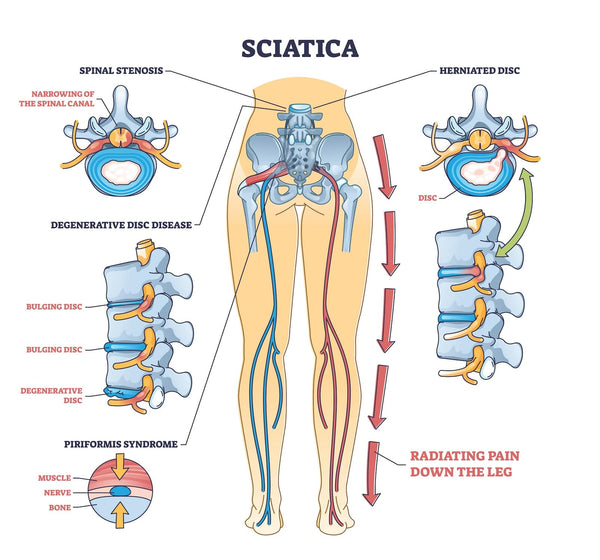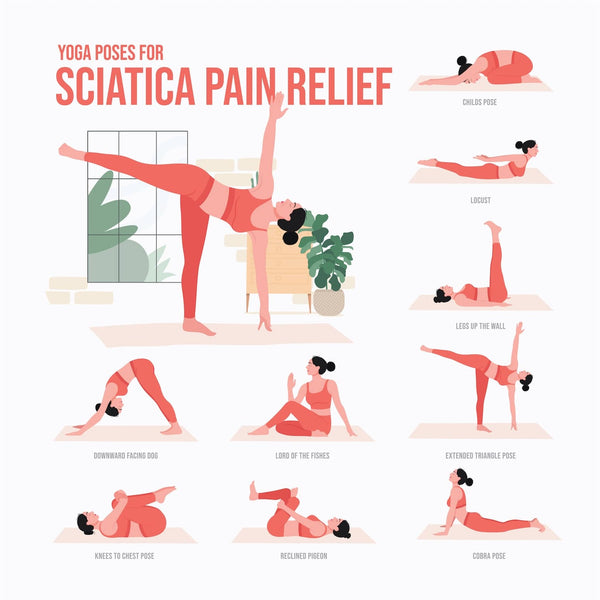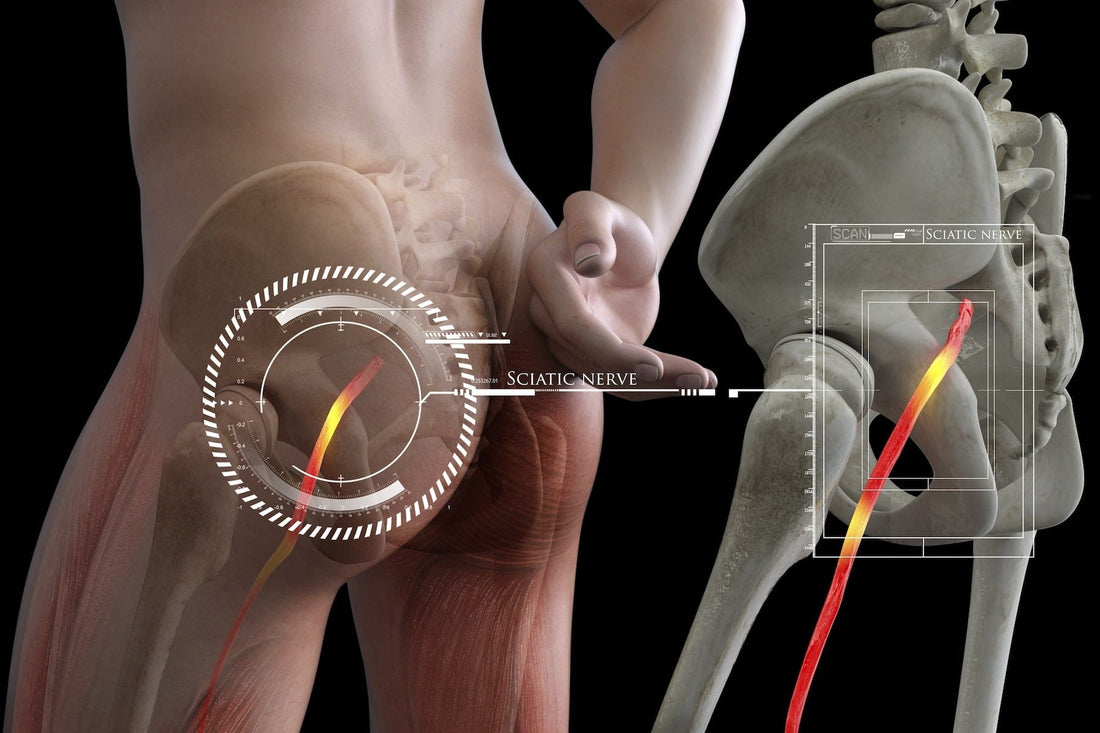Sciatica is a common condition referred to as nerve pain resulting from injury or pressure to the sciatic nerve, affecting about 10% to 40% of people during their lifetime. The sciatic nerve, the longest and thickest in the body, originates from five nerve roots in the spinal cord and extends down each side of the body through the hips and buttocks, reaching just below the knee before splitting into nerves that connect to the lower leg, foot, and toes.
Sciatica symptoms can range from mild to severe and may include pain, tingling, or numbness in the lower back, hips, buttocks, or legs. In more severe cases, symptoms can extend to the feet and toes. Sciatica can manifest in two forms: true sciatica, where the sciatic nerve is directly affected by injury or a condition, and sciatica-like conditions, which mimic sciatica symptoms but arise from other nerve-related issues. Despite the distinction, both forms are generally called sciatica in medical contexts.
The primary cause of sciatica is often a herniated disk or bone overgrowth pressing on the lumbar spine nerve roots, leading to inflammation and pain along the sciatic nerve's path. While sciatica can be debilitating, many cases, especially those caused by herniated disks, improve with treatment within a few weeks to months. However, severe sciatica presenting with significant leg weakness or changes in bowel or bladder function may require surgical intervention. Sciatica is rare before age 20 unless related to an injury, highlighting the importance of understanding its symptoms and treatment options for effective management and relief.
Sciatica Symptoms
Sciatica is a condition characterized by pain that radiates along the path of the sciatic nerve, which extends from the lower back through the buttocks and down the legs. The symptoms of sciatica can vary in intensity and nature, ranging from a mild ache to a severe burning sensation or an electric shock-like feeling. Commonly, sciatica pain worsens with coughing, sneezing, bending, or lifting, particularly when lying on one's back. It is also noted that sciatica typically affects only one side of the body.
The primary symptoms of sciatica include:
- Pain: Described as burning, electric shock-like, or shooting, especially down the leg on the affected side.
- Tingling or "Pins and Needles": Similar to the sensation experienced when a leg "falls asleep" due to prolonged pressure.
- Numbness: A lack of sensation in the affected areas, indicating disrupted signal transmission to the brain.
- Muscle Weakness: Indicates difficulty in muscle command signals reaching their intended destinations.
-
Urinary or Fecal Incontinence: Representing very severe cases where control signals for the bladder and bowels are compromised.

Sciatica Causes
The causes of sciatica are varied, stemming from any condition that impacts the sciatic nerve or the spinal nerves that converge to form it. These conditions include:
- Herniated Disks: When the cushion between spinal vertebrae protrudes and presses on nerves.
- Degenerative Disk Disease: The breakdown of disks, which can lead to nerve pressure.
- Spinal Stenosis: Narrowing of the spinal canal that houses the nerve roots.
- Foraminal Stenosis: Narrowing of the openings where nerve roots exit the spine.
- Spondylolisthesis: A condition where one vertebra slips over another.
- Osteoarthritis: The wear and tear of spinal joints that can lead to nerve compression.
- Injuries: Trauma that directly affects the spine or sciatic nerve.
- Pregnancy: Changes in the body and increased pressure on the sciatic nerve during pregnancy.
- Tumors, Cysts, or Other Growths: Abnormal growths can press on the sciatic nerve.
- Conus Medullaris Syndrome: A rare disorder affecting the spinal cord's lower tip.
- Cauda Equina Syndrome: An emergency involving extreme pressure and swelling of the nerves at the end of the spinal cord.
Understanding the symptoms and causes of sciatica is crucial for seeking appropriate treatment, which can range from conservative management to surgical interventions in severe cases.
Sciatica Risk Factors
Various risk factors can influence sciatica. These factors range from lifestyle choices to physiological conditions, and understanding them is crucial for preventing and managing sciatica. The primary risk factors for developing sciatica include:
- Age-Related Factors: Normal wear-and-tear on the spine due to aging can lead to conditions like herniated disks, bone spurs, and osteoarthritis, which can cause sciatica. People between the ages of 20 to 50 are more likely to experience herniated disks, while bone spurs are more common in older individuals.
- Obesity and Excess Weight: Carrying extra weight stresses the spine, similar to how a construction crane operates under heavy loads. This increased load can lead to back strains, pain, and other related issues that contribute to the development of sciatica.
- Occupational Hazards: Jobs that involve heavy lifting, bending, twisting the back, carrying heavy loads, or driving for long periods may increase the risk of developing lower back problems and, by extension, sciatica. Conversely, occupations that involve prolonged sitting, especially without proper back support, can also pose a risk.
- Lack of Physical Activity: Sedentary lifestyles and prolonged sitting can contribute to an increased risk of herniated disks and sciatica. Regular movement and exercise are important in maintaining spine health.
- Insufficient Core Strength: A strong core supports the spine and can mitigate the risk of sciatica. It acts like upgrading the components of a crane to handle heavier loads, where the muscles of the abdomen help anchor the back muscles.
- Diabetes: People with diabetes, especially type 2, are at increased risk of peripheral neuropathy, a condition that damages nerves, including those that can cause or contribute to sciatica.
- Tobacco Use: Nicotine use can impair circulation and increase the risk of chronic pain conditions, including sciatica, by affecting the health of the spinal tissue and potentially leading to nerve damage.
- Improper Posture and Lifting Techniques: Even physically fit individuals can be prone to sciatica if they do not employ proper body mechanics during physical activities like weight lifting and strength training.
- Unknown Causes: It's important to note that, despite identifying common risk factors, many cases of sciatica occur without a discernible cause that healthcare providers can pinpoint.
Recognizing these risk factors is essential for individuals to take proactive steps to prevent sciatica or effectively manage the condition if it arises. This includes maintaining a healthy weight, ensuring proper posture and lifting techniques, staying active, and managing chronic conditions like diabetes.
Sciatica Complications
While many individuals fully recover from sciatica, often even without treatment in cases caused by herniated disks, there are potential complications associated with the condition that can lead to more serious, long-term issues. These complications primarily revolve around nerve damage, which can manifest in several ways:
- Chronic Pain: A possible complication of sciatica is the development of chronic or long-term pain. This can persist even after the initial cause of the sciatica has been addressed.
- Muscle Weakness: Serious damage to the affected nerve can result in chronic muscle weakness. A common manifestation of this is "drop foot," where nerve damage leads to numbness in the foot. This condition can make normal walking difficult or even impossible due to the inability to lift the front part of the foot.
- Permanent Nerve Damage: In some cases, sciatica can cause permanent damage to the sciatic nerve. This may result in a loss of feeling in the affected leg, severely impacting the individual's quality of life.
- Loss of Bowel or Bladder Control: An serious complication of sciatica involves the loss of control over bowel or bladder functions. This is a sign of cauda equina syndrome, a severe but rare disorder that requires immediate medical attention.
Given these potential complications, it is crucial for individuals experiencing sciatica symptoms, especially loss of feeling or weakness in the affected leg, to seek medical attention promptly. Early intervention can help mitigate the risk of long-term damage and improve the likelihood of a full recovery.
Sciatica Diagnosis
Diagnosing sciatica involves a comprehensive approach that includes reviewing the patient's medical history, conducting a thorough physical examination, and performing specific diagnostic tests to confirm the condition and rule out other potential causes of the symptoms.
Physical Examination
During the physical examination, healthcare providers look for signs and symptoms that are characteristic of sciatica, including changes in how a patient walks, which may indicate sciatica. Specific assessments may include:
- Walking Analysis: Observing for visible changes in walking patterns that might be caused by sciatica.
- Straight Leg Raise Test: The patient lies flat with legs straight, and the healthcare provider slowly raises each leg and asks when pain or other symptoms, like tingling or numbness, begin. This test helps pinpoint the sciatica's cause.
- Muscle Strength and Reflex Checks: These include asking the patient to walk on their toes or heels, rise from a squatting position, and lift each leg one at a time while lying on their back. These tests assess muscle strength, flexibility, and the presence of any nerve-related issues.
- Other Flexibility and Strength Assessments: To determine if other factors might be causing or contributing to the patient's sciatica symptoms.
Diagnostic Tests
To further diagnose sciatica and differentiate it from other conditions that might present with similar symptoms, several tests may be employed:
- Spine X-rays or CT Scans: These can reveal mechanical changes in the spine that may affect nerve roots.
- MRI Scans: Utilize a powerful magnet and radio waves to produce detailed cross-sectional images of the back, highlighting issues like herniated disks or pinched nerves.
- CT Myelogram: Involves injecting dye into the spinal canal before taking X-rays, making the spinal cord and nerves more visible.
- Nerve Conduction Velocity Studies and Electromyography (EMG): Measure electrical impulses produced by nerves and muscle responses, helping to confirm the severity of the nerve root injury.
These diagnostic approaches allow healthcare providers to accurately identify sciatica and tailor a treatment plan suited to the individual's specific condition and needs.

Pain Management and Treatment for Sciatica
The management and treatment of sciatica aim to reduce pain, increase mobility, and address the underlying causes of nerve irritation. Treatment strategies range from self-care measures for milder cases to more intensive interventions, including severe or persistent sciatica surgery. Here's an overview of the treatment options available:
Self-Treatment
Self-care is often effective for managing mild sciatica symptoms. Key self-treatment measures include:
- Ice Packs: Applying cold or ice packs to the affected area can reduce pain and swelling in the initial days following the onset of sciatica pain.
- Heat Therapy: Switching to heat therapy after the first few days, using a heating pad or warm compress to alleviate discomfort.
- Over-the-counter Medications: NSAIDs can help reduce pain, swelling, and inflammation.
- Stretching and Physical Activity: Proper stretching under the guidance of an experienced instructor and engaging in low-impact exercises can be beneficial.
Conservative Treatments
When self-care is not enough, the following conservative treatments may be recommended:
- Prescription Medications: This Includes painkillers, muscle relaxants, antidepressants, and anti-seizure medications to manage symptoms.
- Physical Therapy: Tailored exercises to reduce pressure on the sciatic nerve and alleviate symptoms.
- Spinal Injections: Corticosteroid injections can offer short-term relief by reducing inflammation around the nerve.
- Alternative Therapies: Chiropractic care, yoga, acupuncture, massage therapy, and biofeedback can offer additional relief.
Surgery
Surgery is considered when conservative treatments fail and if there is evidence of nerve damage, severe pain, or significant impact on daily activities. Surgical options include:
- Diskectomy: Removal of herniated disk fragments pressing on the sciatic nerve.
- Laminectomy: Removal of part of the vertebra (lamina) to relieve pressure on spinal nerves.
Additional Medical Treatments
For cases not responding to self-care, medications such as corticosteroids, antidepressants, anti-seizure drugs, and, in some cases, opioids may be used to manage pain. Steroid injections directly into the nerve area can also reduce pain and inflammation. These treatments aim to provide relief and improve the quality of life for individuals suffering from sciatica.
In summary, the treatment for sciatica is multifaceted, involving a combination of self-management techniques, conservative treatments, medication, and possibly surgery, depending on the severity and persistence of symptoms. Individuals with sciatica must consult healthcare professionals to determine the most appropriate treatment plan for their situation.
Sciatica Prevention
Several preventive measures can be adopted to minimize the likelihood of developing sciatica or to lower the risk associated with its onset. These strategies focus on lifestyle adjustments and proactive health management:
- Adopt Proper Posture: Ensuring correct posture while sitting, standing, lifting, and sleeping is crucial for spinal health and can prevent undue pressure on the sciatic nerve.
- Avoid Tobacco Products: Nicotine consumption, including smoking and vaping, compromises bone blood supply, potentially weakening the spine. Avoiding tobacco products is essential for maintaining spinal strength.
- Maintain a Healthy Weight: Consulting with a healthcare provider for dietary and physical activity recommendations is key. A balanced calcium and vitamin D intake is also important for bone health.
- Engage in Regular Physical Activity: A combination of exercises, from stretching and strength training to core strengthening and aerobic workouts, supports back health and aids in achieving a healthy weight.
- Wear Proper Footwear and Use Compression Socks: Shoes that provide adequate support can prevent falls, while compression socks may improve circulation and reduce the risk of swelling, offering additional protection against conditions that could exacerbate sciatica.
- Safeguard Against Falls: Keeping living spaces free of obstacles, ensuring adequate lighting, and installing safety features like grab bars and stair rails can significantly reduce the risk of falls that might lead to sciatica.
- Allow Time for Recovery: Ignoring back pain can result in further injury. However, staying moderately active with low-impact exercises such as swimming, walking, yoga, or tai chi can aid in recovery without exacerbating the condition.
By implementing these preventive measures, individuals can reduce the risk of sciatica and promote overall spinal and bone health, contributing to a more active and pain-free lifestyle.
Ease Sciatica Pain with Viasox Compression Socks
Sciatica pain can make walking, sitting, and even standing a challenge. Viasox Compression Socks are here to help ease that discomfort. These socks are specially designed to reduce the pain and swelling associated with sciatica by improving circulation with gentle compression. While also suitable for diabetics managing swelling, the focus is on providing relief from sciatica's radiating pain. Comfortable for all-day wear, Viasox socks support your journey to a more pain-free day, making them a great choice for anyone looking to lessen sciatica symptoms and improve mobility.





